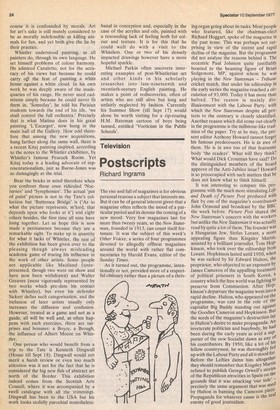Television
Postscripts
Richard Ing rams
The rise and fall of magazines is for obvious personal reasons a subject that interests me. But it can be of general interest given that a magazine often reflects the mood of a particular period and its demise the coming of a new mood. Very few magazines last for more than twenty years, so the New Statesman, founded in 1913, can count itself fortunate. It was the subject of this week's Other Voices; a series of four programmes devoted to allegedly offbeat magazines around the world with rather flat commentaries by Harold Evans, editor of the Sunday Times.
As it turned out, the programme, intentionally or not, provided more of a respectful obituary rather than a picture of a thriv ing organ going about its tasks. Most people who featured, like the chairman-elecl Richard Hoggart, spoke of the magazine in the past tense. This was perhaps not surprising in view of the recent and rapid decline of the magazine. But the programme did not analyse the reasons behind it. The eccentric Paul Johnson quite justifiably boasted to the beaming figure of Brian Sedgemore, MP, against whom he was playing in the New Statesman — Tribune cricket match, that under his editorship in the early sixties the magazine reached a circulation of 93,000. Today it has more than halved. The reason is mainly disillusionment with the Labour Party, with which the New Statesman despite all protests to the contrary is closely identified. Another reason which did come out clearly in the programme is the millstone-like tradition of the paper. Try as he may, the present editor Anthony Howard cannot forget his famous predecessors. He is in awe of them. He is in awe too of that fearsome body 'the readers'. What will they think? What would Dick Crossman have said? Do the distinguished members of the board approve of the Anti-Jubilee issue? Howard is so preoccupied with such matters that he does not know what to think himself.
It was interesting to compare this programme with the much more stimulating Life and Death of Picture Post produced with flair by one of the magazine's contributors John Ormond and broadcast by the BBC the week before. Picture Post shared the New Statesman's concern with the workers but unlike the New Statesman it was actually read by quite a lot of them. The founder was a Hungarian Jew, Stefan Lorant, a more appealing figure than Kingsley Martin, assisted by a brilliant journalist, Tom H0Pkinson, who took over the editorship from Lorant. Hopkinson lasted until 1950, when he was sacked by Sir Edward Hutton, the proprietor, who objected to an exposure hY James Cameron of the appalling treatment of political prisoners in South Korea, a country which the free world was fighting tn preserve from Communism. After 1-101)kinson's departure the magazine went into a rapid decline. Hutton, who appeared on the programme, was cast in the role of the capitalist Big Baddy standing out against the Goodies Cameron and Hopkinson. But the seeds of the magazine's destruction lay in Hulton's desire to make propaganda. An inveterate politician and busybody, he had been during the early years as avid a sup; porter of the new Socialist dawn as any 01 his contributors. By 1950, like a lot of his, fellow countrymen, he was thoroughlY fen up with the Labour Party and all it stood for. Before the Lefties damn him altogether they should remember that Kingsley Martin refused to publish George Orwell 's of the Republican atrocities in Spain on the grounds that it was attacking 'our side' precisely the same argument that was used by Hutton in banning the Cameron piece: Propaganda for whatever cause is the real enemy of good journalism.






























 Previous page
Previous page